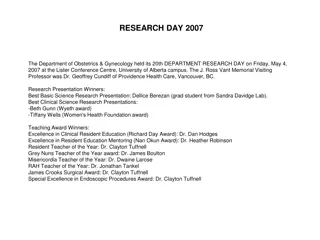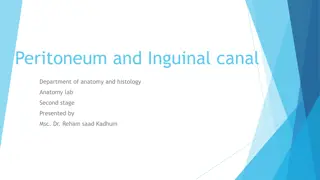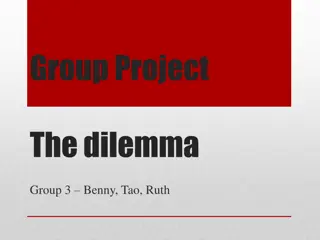Diagnostic Dilemma in a Case of Hemo-peritoneum in Obstetrics
A 25-year-old pregnant woman presented with a history of blunt trauma, diffuse pain, and urinary retention. Despite a normal initial ultrasound, she developed breathlessness and urinary issues. Clinical examination revealed significant pallor and diffuse abdominal tenderness. This case highlights the importance of clinical judgment in diagnostic workup, emphasizing the need to consider clinical findings alongside imaging results in managing complex obstetric cases.
Download Presentation

Please find below an Image/Link to download the presentation.
The content on the website is provided AS IS for your information and personal use only. It may not be sold, licensed, or shared on other websites without obtaining consent from the author.If you encounter any issues during the download, it is possible that the publisher has removed the file from their server.
You are allowed to download the files provided on this website for personal or commercial use, subject to the condition that they are used lawfully. All files are the property of their respective owners.
The content on the website is provided AS IS for your information and personal use only. It may not be sold, licensed, or shared on other websites without obtaining consent from the author.
E N D
Presentation Transcript
CASE OF HEMO-PERITONEUM A DIAGNOSTIC DILEMMA Dr NIKHILA SINGIREDDY JR-2, Unit-IV Department of Obstetrics and Gynaecology Dr.D.Y.Patil Medical College, Pune
AIM OF PRESENTING THIS CASE Selecting a case for presentation to a mixed audience and not speciality specific, is always a difficult task. Keeping this in mind I chose this case not to highlight a rare case or any management marvel in obstetrics,but just to stress on an age old teaching: Clinical impression reigns supreme in a diagnostic work up
CASE REPORT 25 year old G3P2L2 with 3 months of amenorrhea reported to labour room at 18:00 hrs with complaints of H/o blunt trauma on the abdomen 15 days back followed by diffuse pain, she got an USG done after the trauma which showed no obvious abnormality*. Breathlessness on exertion and unable to pass urine since 9 hours.** No h/o nausea or vomiting Bowel constipated, last stool passed on the previous night * USG report : SLIUG of 15 weeks of gestation. **bladder catheterized 1000ml urine drained catheter left in situ
Past menstrual history :- Regular cycles LMP :- 5/1/2020 BD :- 15.3weeks By her 1StUSG done at 14.1weeks, her gestational age 15.1 weeks Obstetric history :- - Previous 2 full term normal deliveries with out any complications No significant past, personal and family history.
On examination GC The most striking feature was the significant pallor . VITAL PARAMETERS on admission Pulse 90 bpm Blood pressure 110/80 mmHg Respiratory rate 20 / minute Temperature 98.1 SPO2 98% on room air
Systemic Examination Cardiovascular examination:- S1 and S2 heard. No added sounds. Respiratory examination :- Bilateral air entry equal. Per abdominal Examination:- Inspection:- No obvious abnormality Palpation :- Diffuse tenderness all over abdomen Rebound tenderness + because of the tenderness and voluntary guarding , uterine height could not be properly assessed Auscultation : Bowel sounds sluggish Per speculum examination :- Cervix and vagina healthy, No bleeding Per Vaginal examination :- Uterus around 14-16 weeks, no significant forniceal tenderness
Laboratory Investigations Haemoglobin 6.3gm% TLC 14500 (N-88, L-8, M-3, E-1) Platelet count 2.10lakh/mm3 Urine RE/ME No abnormality detected Renal function test WNL LFT - WNL
Clinical Impression From the above clinical findings of rebound tenderness with severe pallor and a Hb of 6.3 G% the first impression was that this was a case of HEMOPERITONEUM But our main concern at this point was what could be the CAUSE of hemoperitoneum in mid pregnancy ????? Could it be Pregnancy related Ectopic ( Unlikely at this gestation), Traumatic rupture of uterus (Then why reporting after 15 days) OR was it a Surgical etiology So the next step was to extend our clinical hand and look for fresh ultrasonography findings
First USG in our hospital USG was done first by resident on call and his impression was: Single intrauterine viable pregnancy of 15.1 weeks, Liver & Spleen WNL *In the meantime we had already sent a call for the surgical resident for review to exclude any surgical cause
COULD IT BE A CASE OF UTERINE RUPTURE? BUT ETIOLOGY? This was the persistent query hovering in our minds. There was no obvious precipitating factor. The dilemma was increasing by the minute Ultrasonologically it was an intrauterine viable pregnancy clinically vital parameters were maintained and WNL Hence, we requested for a faculty review of the USG and we specifically asked to look for the integrity of the uterine wall to rule out silent rupture of the uterus.
The second ultrasound USG report of the second ultrasound done by faculty reported SLIUG of 15.5 weeks with ?subchorionic bleed and free fluid in the peritoneal cavity
Once the USG reporting was done , we had two options in front of us Possibility of early separation of the placenta ( subchorionic bleed) Plan : transfuse blood, build hemoglobin and follow up with a MRI the next morning OR Possibility of a rupture uterus Plan : immediate laparotomy Going by clinical findings of severe pallor with rebound tenderness (even though vital parameters WNL and no USG evidence of rupture) we were convinced to go ahead with immediate laparotomy, but to further validate our decision we requested for tapping that revealed hemoperiteum. Surgical Resident had landed up when the USG was on. He too concurred with the plan. We requested him to ask his faculty to be present for the laparotomy to help tackle any surgical surprise.
INTRA-OPERATIVE FINDINGS LIVE INTRA UTERINE GESTATION Hemoperitonium of approx 2 Ltrs. Bicornuate uterus with ruptured right uterine horn containing a live fetus enclosed in the amniotic sac and in HEMOPERITONIUM process of expulsion.
SITE OF RUPTURE BICORNUATE UTERUS
DISCUSSION Here was a case where there was a dilemma of deciphering the cause of the hemoperitoneum at 15 weeks of gestation, known to be a safe period in pregnancy. Commonest cause of hemoperitoneum in 1st trimester is ectopic pregnancy and rupture of uterus in latter half of pregnancy. Some reported causes of hemoperitoneum in the mid trimester are 1. Endometriosis 2. Organ rupture due to Trauma 3. Vessel rupture 4. Placenta percreta
Conclusion Hemoperitoneum in absence of evident risk factors is often associated with non- specific signs/symptoms leading to delay in diagnosis In this case even with normal vital parameters, non specific USG findings, clinically we betted on rupture of uterus and our hunch was vindicated by the laparotomy.
Take home message Clinical diagnosis still holds a very important place in sieving through the maze of differential diagnosis and zeroing down to the final diagnosis























